|
Fokker Eindecker
“Die erste kannonen”
Dual Combo
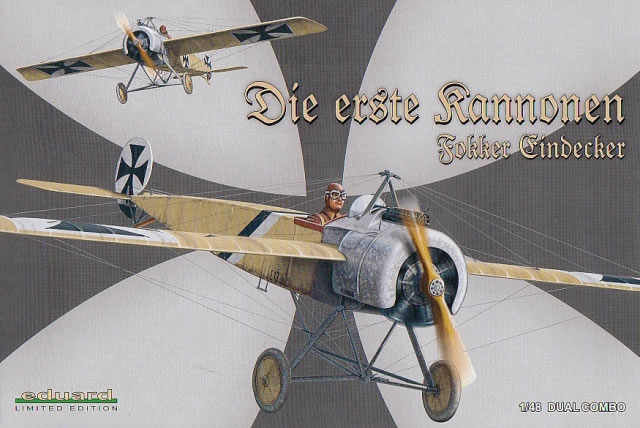
Eduard, 1/48 scale
S
u m m a r y |
| Catalogue Number: |
Eduard Kit No. 1141 - Fokker Eindecker “Die erste kannonen” |
| Scale: |
1/48 |
| Contents and Media: |
200 parts in tan coloured plastic; 169 photo-eched parts; 2 clear parts; markings for five aircraft |
| Price: |
USD$74.95 available online from Eduard
and hobby retailers worldwide |
| Review Type: |
FirstLook |
| Advantages: |
A plethora of items; crisp detail, unblemished wings with sharp trailing edges, multitude of optional parts included, both coloured and standard photo etched frets, nicely cast resin figures; “Iron Cross” dress pin; pilot portraits for framing; decals with a minimum of carrier film, and the inclusion of stencil data |
| Disadvantages: |
Unnecessary portrayal of fuselage “tapes”. |
| Conclusion: |
A cutting edge kit of a perennial favourite. The kit contains excellent detail with an abundance of parts to choose from. The extras associated with “Dual Combo” releases are appreciated and are up to the usual high standards set by this manufacturer. Careful study of your chosen subject is highly recommended however. This is due to the many conflicting references regarding the Eindecker family. |
Reviewed by
Rob Baumgartner

Eduard's 1/48 Fokker Eindecker Dual Combo is available online from Squadron.com
Eduard‘s latest version of this famous fighter now appears in the popular “Dual Combo” range.
This means you get two complete aircraft in the one offering as well as a healthy swag of extras.
The kit oozes quality from the moment one pries open the box. Inside there are nearly 200 plastic parts which are contained on 6 tan coloured sprues. The windscreens come courtesy of some clear transparencies and a masking set is provided to assist with the painting.
There are also a couple of frets of photo etched items. The larger sheet numbers over 140 parts while the other pre-coloured example displays a further 28.
Complimenting this are a couple of 1:48 scale resin figures, a set of portraits representing 2 Eindecker aces, and an 18mm “dress pin” of the Iron Cross.

It’s clear from the beginning that a lot of effort has gone into this kit and it’s most evident in the cockpit area. The large opening is a magnet for inquisitive eyes so it’s important that Eduard pack as much detail into this area as possible.
Fortunately they have, as nearly 50 items are devoted to the interior. Some deft painting will bring out the wire bracing and stitching detail, after which the separate structural framework can be added. With the addition of the floor, engine bulkhead and rear “fabric” screen, the interior is ready for some serious detailing.
Obviously items such as the seat, control column, and rudder bar are par for the course, but there is also a pressure pump, throttle, main fuel tank, coloured seat belts, ancillary engine parts, shock cords, and seat mounts.
Under the forward cowling is where the compartmented fuel/oil tank, ammo bins, switch panel, and other such details hide. When fitted over the cockpit, there is not a lot more that can be added. If you feel the need, an oil pulsator can also be fabricated as this is absent from the starboard side.
The fit of these parts is excellent although care will be needed to make sure everything is lined up correctly at each stage of the building process. One slip early on will have ramifications down the line. Note that you may have to decrease the height of the rudder bar so that this area doesn’t interfere with the tubing on the firewall.
There is one unusual feature that can be found on the exterior of the fuselage. Eduard decided to portray raised “tapes” corresponding to the position of the interior’s structural tubing. These should not be present and period photographs confirm this.
This boxing tries to cover a number of Eindecker options and this is where things get tricky.
Differentiating between the E.I (M 5KMG), E.I (M 14) and E.II (M 14) can be nightmare. This is compounded when even surviving Idflieg and Fokker records differ markedly in dimensional data.
Some respected authorities claim the wings of the E.II and the E.III were the same…while other notables say that those of the E.II were shorter. There is also controversy regarding the fuselage length of the E.I and E.II, not to mention any detail differences.
Naturally this also puts the kit manufacturer in a quandary.
Eduard’s initial 1994 release was faithful to Ian Stair’s E.III plans which appeared in Albatros Productions Datafile 15 (despite a different rib count on the wings). This incarnation is similar in outline although it is clear that alternative reference sources have been used.
It is obvious that an accurate rendition of all options cannot be built straight from the box. The modeler will thus have to study their subject carefully to decide what changes, if any, they deem important enough to make.
Two sets of wing are included and these are to accommodate the different cowl cheeks. Both square and triangular versions are supplied, with each wing having the corresponding cut-out at the inboard leading edge.
Speaking of which, these flying surfaces are superbly moulded. The trailing edges are commendably thin and the rib tapes are represented as raised strips. None of the parts show any sign of deformity which is a commendable piece of engineering.
A lot of extra detailing comes courtesy of the two frets of p-e. Aside from the aforementioned seat belts, the coloured items include a “wooden” switch panel, dial faces, wing mounted compass and even a map.

Part 2 of this medium is dedicated to the engine, machine guns (both LMG 08/15 and Schwarzlose items are present), fabric eyelets, stitching, turn buckles, ammunition belts, control horns, cowl straps, filler caps, trigger, etc, etc, etc. Eagle-eyed enthusiasts will welcome the spoked wheels and improvised headrest that make their way into this release!
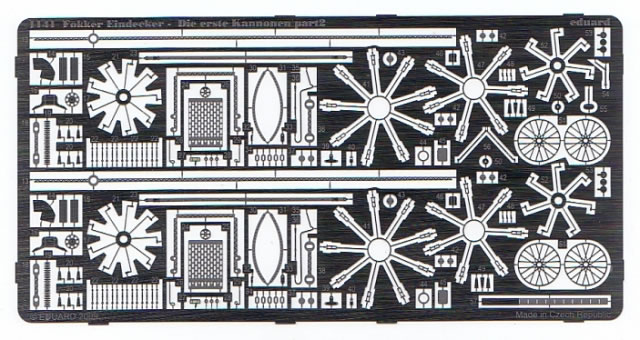
One thing that the cowling does miss though is the blast plate under the machine gun muzzle.
Both Germania and Garuda airscrews are supplied and these fit onto the well appointed rotary engines.
The undercarriage and struts are well in scale and have been moulded with as much of the final assembly in place as possible. This adds some strength to these delicate components and the softer plastic allows handling that would normally snap these items in the cleanup process.
Some aircraft were seen with streamlined attachments to this tubing. Eduard spotted the detail and has provided the modeler with “add-ons” for the appropriate members. The instructions call for these to be applied on both sides of the strut but clearly only the rear portion is necessary.
The displayed rigging can be a challenge if one wants to replicate that seen on the original. Eduard helps the builder down the path of authenticity by supplying the various wheels and termination points as photo-etched parts. It adds a touch of finesse but does require a deft hand when adding your favourite rigging material.
Bonuses
To give your subject a sense of belonging, two resin pilot figures are supplied. These are very well cast and will greatly enhance any diorama. They depict Max Immelmann and Oswald Boelcke, two of the aces that flew these fighters.
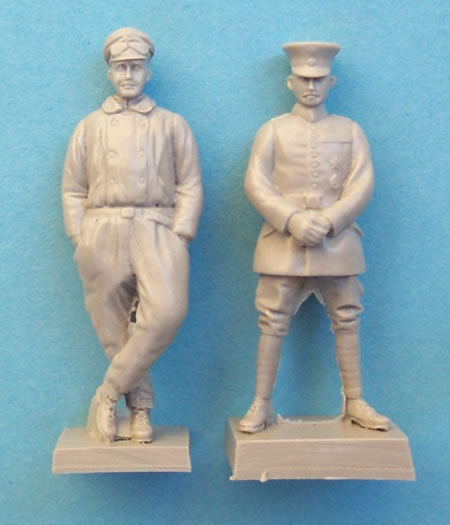
A portrait of each is also supplied along with a biography on the back. These are ideal for framing and will enhance any display.
Topping it off is a nicely reproduced “Iron Cross”, suitably scaled down for wearing to your next club meeting.
Marking Options
There are 5 subjects catered for and these are located on 2 decal sheets.
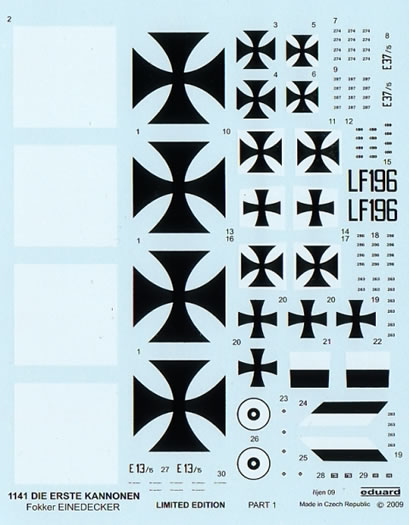
They are beautifully printed with all items in perfect register. The minimal carrier film is thin, yet strong enough to allow positional changes during application.
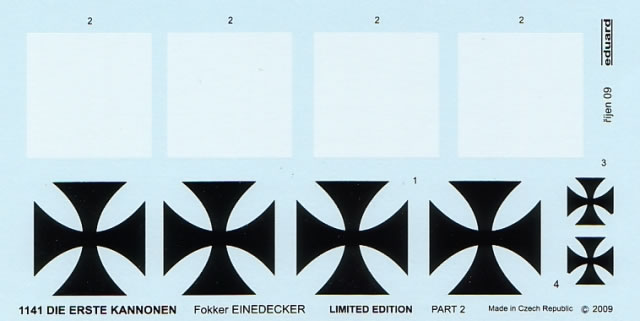
An excellent selection of stenciling is also provided and this includes logos for the propeller and data plates.
- Fokker E.I 13/15, flown by Max Immelmann, FA 62, France, August 1915
Immelmann was officially credited with 15 victories before controversially losing his life on 18 June 1916. He was claimed by a FE2b of 25 Squadron although there is evidence that he shot off his own propeller due to malfunctioning gun synchronization gear.
- Fokker E.II, flown by Otto Parschau, Kagohl 1, Belgium, early 1916.
Parschau scored 8 times before meeting his death, this being brought about after receiving severe chest and head wounds on 21 July 1916. He had gained the coveted Pour le Merite only 11 days earlier.
- Fokker E.I flown by Ernst Freiherr von Althaus, FA 23, 1915.
Ernst survived the war with a total of confirmed 9 victories and a claim for a further 8. Failing eyesight saw him relieved of any combat flying in 1917 and he later returned to Army duties. He became an interpreter after WW2 for the Allied Armistice Commission before passing away on 29 November 1946.
- Fokker E.II, flown by Oswald Boelcke and Max Immelmann, October 1915.
Boelcke amassed an amazing 40 victories before losing his life at the age of 25. On 28 October 1916, his aircraft collided with that of Erwin Bohme. Bohme survived the incident but fate was not so kind to his friend.
- Fokker E.III, flown by Gotthard Sachsenberg, MFA, Belgium, 1915
Sachsenberg was another ace to survive the war and lived to the age of 69. His score amounted to 31 victories; nearly all of them with MFJ I. Luftwaffe fans may be familiar with his cousin Heinz, who managed 104 victories with JG 52.
The Fokker Eindecker is one of those iconic aircraft that deserves to be in any WWI aircraft collection.
Eduard gives you that opportunity with a generous package of well moulded plastic and delicately etched metal items. The latter allows a finesse of detail that is essential for a subject such as this. As a result, the assembly process requires more care than usual for an Eduard WWI release… but its well worth it.
The decision to portray the prominent “tapes” on the exterior of the fuselage was a disappointment and sanding these off is recommended. One must also check their subject carefully as many subtle changes can be found among the types. That shouldn’t discourage you from the kit however, as it is a joy to build and patience will reward.
Being a “Dual Combo”, we also get the nicely sculptured figures. And along with their portraits and the 18mm dress pin, this all adds up to yet another satisfying package.
Thanks to Eduard for the sample
Review Text Copyright © 2009 by Rob Baumgartner
Page Created 28 December, 2009
Last updated
28 December, 2009
Back to HyperScale Main Page
Back to Reviews Page

|
